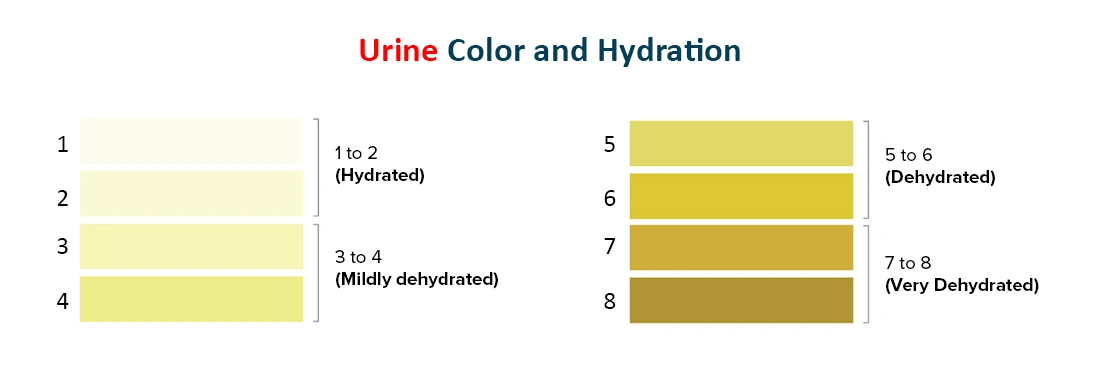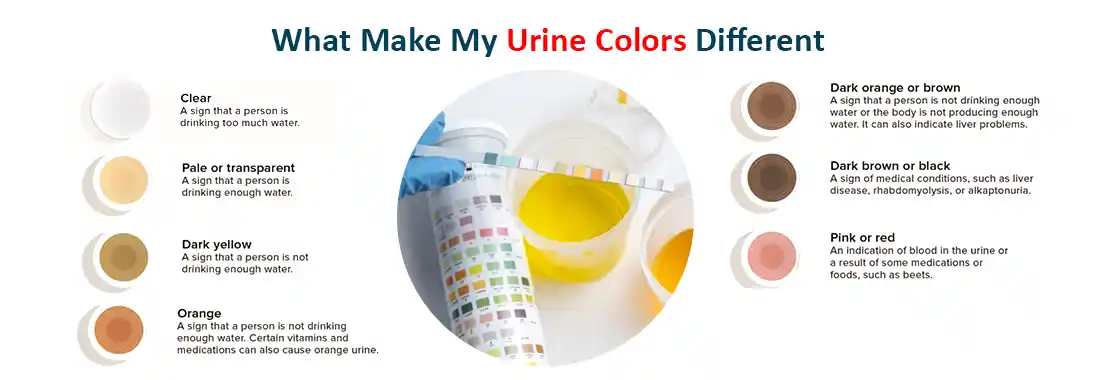
Your body speaks volumes every day, quite literally. Our health is reflected by the output of your body. In case of urinary tract infection, or consuming particular foods, and an individual's health and habits can all...
Your body speaks volumes every day, quite literally. Our health is reflected by the output of your body. In case of urinary tract infection, or consuming particular foods, and an individual's health and habits can all affect the color of their urine.
It is seen that Dark brown urine may indicate liver and kidney illness, while your Clear urine may indicate an excessive hydration.
Urine's usual color is referred as "urochrome." Naturally, the urine has a yellow color. Your urine will be near to clear and have a faint yellow color when you stay hydrated.
Your urine should turn a deep amber or even light brown if you're becoming dehydrated.
Note: The color of your urine might reveal any medical issue that needs to be addressed.

Urine Color and Hydration, What is the relation?
Do I consume enough water?
To determine your level of hydration, it is important to see the urine color chart along with the numbered ordered systems that will give an estimate of the urine color. In order to maintain good health, it's critical to consume good amount of water each day.
1 to 2: Well-hydrated
Urine that is clear, odorless, and copious is frequently a sign of adequate hydration.
Recommendations: Continue to drink at the same pace.
3–4: Slightly parched
Urine that is somewhat darker in color may be an indication that you must consume more water.
Recommendations: You are advised to sip on a glass of water.
5–6: Hydrated but not enough
Urine that is medium-dark yellow frequently indicates dehydration.
Recommendations: You are recommended to drink god amount of water
7- 8: Severe dehydration
In little amounts, darker, stronger-smelling pee may indicate dehydration.
Recommendations You are requested to immediately sip from a large bottle of water.

What may make my urine colors different?
Even if you are well-hydrated, there are foods, drugs, and vitamin supplements that might cause a color change in your urine.
Explaining the Different Colors of the Urine
The color of your urine can change based on your diet, drugs you take, and water intake. While many of these hues are within the range of what "normal" urine can appear like, there are several situations in which strange and different urine colors can raise red flags.
Clear Urine
A person who has clear pee may be consuming a lot of water. By doing this, the blood's electrolyte balance may be affected.
Water tablets, or diuretics, cause a rise in urine production. It's possible for those taking these drugs to urinate more regularly and for their urine to be clean.
Note: In addition to feeling extremely thirsty, diabetes can also make a person urinate more frequently. They could drink more water as a result of this, which might result in clear urine.
Health Alerts: Additionally, conditions such as viral hepatitis and cirrhosis might be indicated by clear urine. See your doctor if you consistently have clear pee and aren't drinking a lot of water.
Yellow to Amber Urine
Urine that ranges from yellow to orange
"Typical" Urine that turns from a pale yellow to a richer amber hue. As you consume more water, the urochrome pigment in your urine naturally becomes more diluted.
Hemoglobin, the protein in your red blood cells that delivers oxygen, is broken down by urochrome. In general, the degree to which this pigment is diluted will determine the color of your urine.
Note: Urine can also appear neon yellow if there is an abundance of B vitamins in the blood.
Dark Yellow Urine
The urine with a dark yellow color
Urine that is dark yellow may be a sign of mild dehydration. Usually, this indicates that individuals should increase their water intake.
Note: According to the Centers for Disease Control and Prevention (CDC) there is no set amount of water that is recommended for consumption each day. But if it's feasible, one could want to aim for about 6–8 glasses of water each day.
Pink and Red Colored Urine
In case of Red or pink urine Foods: Consuming foods like beets, rhubarb, or blueberries that naturally contain rich pink or magenta pigments may cause your urine to appear red or pink.
Medical conditions: There are occasionally other causes for red or pink urine; however, they may be related to anything you recently ate. Hematuria, or the appearance of blood in the urine, is a symptom of several medical disorders, such as an enlarged prostate, kidney stones, and malignancies in the bladder and kidney.
Medication: Certain medications, such as phenazopyridine (Pyridium), rifampin (Rifadin), laxatives with senna, might cause your urine to become reddish or pink.
Urine is Blue or green
In general, blue urine is rare and most likely connected to something (any particular part) in your diet.
Food: Blue or green urine can be caused by food coloring, especially a dye called methylene blue. This dye is in many types of candy and some medications.
Medications: Medications that can cause blue or green urine cimetidine (Tagamet), amitriptyline, indomethacin (Indocin), promethazine (Phenergan), and vitamin B supplements.
Medical procedures: It can also result from dyes in medical tests performed on your kidneys or bladder.
Medical conditions: The Pseudomonas aeruginosa bacterial infection can also cause your urine to turn blue, green, or indigo purple.
Urine is Cloudy
The following factors may contribute to the hazy appearance or cloudy appearance of your urine:
Medical conditions: A urinary tract infection may be indicated by cloudy urine. Additionally, it may be a sign of certain chronic illnesses including renal disorders. Urine that appears hazy occasionally is another indication of dehydration.
Pregnancy: Cloudy urine during pregnancy may indicate preeclampsia, a potentially fatal illness. If you experience hazy or foamy urine while pregnant, you should notify your healthcare provider right once.
Pneumaturia, or cloudy urine, is defined as urine that contains bubbles or foam. This may indicate the presence of severe medical diseases such as diverticulitis or Crohn's disease.
Frequently Asked Questions (FAQs)
What are the early warning signs of kidney disease?
- Less Urine
- Frequent Urination
- Swollen arms and legs
- Muscle Cramps
- Insomnia
- Fatigue
What color is urine in stage 2 kidney disease?
Your urine may have the characteristic yellow hue of Stage 2 Kidney Disease, which typically has no symptoms or very moderate symptoms. Even in stage 2, kidney disease patients may have increased proteinuria or albuminuria in their urine, which can cause frothy urine. It might be necessary to flush more than once.
Some people's urine (hematuria) may contain trace amounts of blood, giving it a more amber or darker yellow hue.
What is Stage 3 Chronic Kidney Disease?
Your eGFR falls between 30 and 59 in Stage 3 CKD. Additionally, there can be protein in your pee, or urine. There is damage to your kidneys that impairs their functionality, and you may begin to experience symptoms. While kidney damage is usually irreversible, there are few things you may take to prevent further damage from occurring.
Important
If you do not currently have a nephrologist, or kidney specialist, discuss finding one with us and avail free doctor’s consultation with my MD Radiologist. Together, you and your nephrologist can create a personalized treatment plan.
In addition, we can monitor the health of your kidneys, typically every 90 days or three months.
For Free Consultation from the Doctor
Contact- Dr. Ravin Sharma, (MBBS, MD in Radiology)
Available: 24*7*365
Phone Number: +919212125996
Significance
The colors on this chart are meant to be used as a reference only; they are not meant to take the place of medical advice. If you have concerns about the color of your urine, the quantity of water you consume, or dehydration, talk to your doctor.
Why Ganesh diagnostic and Imaging Centre should be your preference to for understanding your Urine tests for the same?
Ganesh Diagnostic and Imaging Centre has a long history of offering its patients exceptional service and attention. Years' worth of happy patients in thousands!
Since 2001, it has grown to be a recognized and well-established diagnostic facility.
Their excellence is backed by NABH and NABL Accreditations.
NABH accreditation is proof of highest standard of care and service provided to the patients. NABL accreditation reflects the competency of laboratories and equipment based on some national and international standards.
Test report is available digitally too.
Ganesh Diagnostic and Imaging Centre is a one-stop solution for getting all kinds of tests done, as all services are available under one roof.
The aim of GDIC is to provide world’s finest technology at the lowest price and Free Home Sample Collection Facility.
The rates of scans are reasonably priced. Ganesh Diagnostic and Imaging Centre also offer FLAT 50% OFF on many tests.
We also provide- Free Home Sample Collection, Free Ambulance Service an d Free Consultation from the Doctor itself.
Book Your Online Test and Get Early Appointment
Ganesh Diagnostic Center promotes great care and concern for patients.
It is our utmost duty to allow a speedy diagnosis and hope that in future, your treatment is done at the earliest.
Thus, we recommend you to book an appointment with us today and book your online blood test for any specific disease, disorder and discomfort.
Avail our digital support system and establish a long lasting relationship with Ganesh Diagnostic Center near you today. Book Now!
Note from Ganesh Diagnostic & Imaging Center
Early checkups are always better than delayed ones. Safety, precaution and care are depicted in the several health checkups at our center.
Here, at Ganesh Diagnostic and Imagining Center, we present simple and comprehensive health packages for any kind of testing to ensure the early prescribed treatment to safeguard your health.
So, visit us at the earliest to ensure good health and to maintain an active immune system









